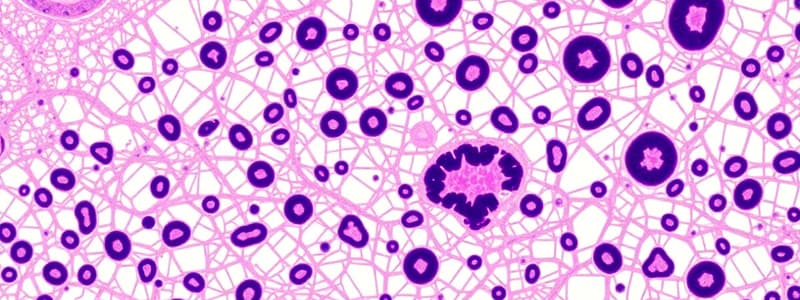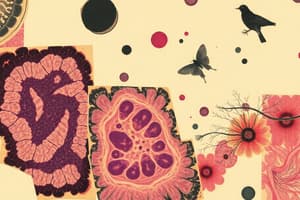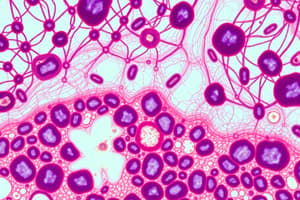Podcast
Questions and Answers
What is the primary function of epithelial tissue?
What is the primary function of epithelial tissue?
- Covers body surfaces and lines cavities (correct)
- Stores energy and transports materials
- Transmits electrical signals
- Provides support and binds organs
Which of the following is a type of connective tissue?
Which of the following is a type of connective tissue?
- Nervous tissue
- Loose tissue (correct)
- Cardiac tissue
- Striated tissue
What distinguishes smooth muscle tissue from skeletal muscle tissue?
What distinguishes smooth muscle tissue from skeletal muscle tissue?
- It is striated and voluntary
- It is the main muscle for posture
- It is involuntary and non-striated (correct)
- It has multiple nuclei
Which type of muscle is found only in the walls of the heart?
Which type of muscle is found only in the walls of the heart?
What is the main role of neurons in the nervous tissue?
What is the main role of neurons in the nervous tissue?
What is the focus of pathological histology?
What is the focus of pathological histology?
Which of the following functions is NOT associated with connective tissue?
Which of the following functions is NOT associated with connective tissue?
Which type of histology focuses on the microscopic structure of organs?
Which type of histology focuses on the microscopic structure of organs?
What is the primary function of dendrites in a neuron?
What is the primary function of dendrites in a neuron?
Which type of neuroglia is responsible for insulating axons in the peripheral nervous system?
Which type of neuroglia is responsible for insulating axons in the peripheral nervous system?
Which histological technique is primarily used to enhance contrast in tissue samples?
Which histological technique is primarily used to enhance contrast in tissue samples?
What is the main role of microglia in the nervous system?
What is the main role of microglia in the nervous system?
What is one of the limitations of light microscopy compared to electron microscopy?
What is one of the limitations of light microscopy compared to electron microscopy?
Which cells are involved in maintaining the blood-brain barrier?
Which cells are involved in maintaining the blood-brain barrier?
Which microscopy technique is best suited for visualizing the external surfaces of cells?
Which microscopy technique is best suited for visualizing the external surfaces of cells?
What is the significance of using fixation in histological techniques?
What is the significance of using fixation in histological techniques?
What is the primary function of simple squamous epithelium?
What is the primary function of simple squamous epithelium?
Which type of epithelial tissue is specialized for the absorption of nutrients?
Which type of epithelial tissue is specialized for the absorption of nutrients?
What type of epithelial tissue would you find in kidney tubules?
What type of epithelial tissue would you find in kidney tubules?
Which epithelial type is characterized by multiple layers and provides a protective barrier?
Which epithelial type is characterized by multiple layers and provides a protective barrier?
Where would you typically find pseudostratified columnar epithelium?
Where would you typically find pseudostratified columnar epithelium?
Which type of epithelium enables stretching, often found in the urinary bladder?
Which type of epithelium enables stretching, often found in the urinary bladder?
What is the primary function of keratinized stratified squamous epithelium?
What is the primary function of keratinized stratified squamous epithelium?
Which type of epithelial tissue can be found in the ducts of some glands and male urethra?
Which type of epithelial tissue can be found in the ducts of some glands and male urethra?
What is a primary function of stratified epithelial tissue?
What is a primary function of stratified epithelial tissue?
Which type of junction prevents leakage between epithelial cells?
Which type of junction prevents leakage between epithelial cells?
Which type of connective tissue is primarily responsible for energy storage?
Which type of connective tissue is primarily responsible for energy storage?
Which characteristic is NOT associated with the structure of epithelial tissue?
Which characteristic is NOT associated with the structure of epithelial tissue?
Which type of cancer originates from epithelial cells?
Which type of cancer originates from epithelial cells?
What is the role of fibroblasts in connective tissue?
What is the role of fibroblasts in connective tissue?
What term describes the protective action of epithelial tissue in response to skin infections?
What term describes the protective action of epithelial tissue in response to skin infections?
Which component of connective tissue provides elasticity?
Which component of connective tissue provides elasticity?
What role does dopamine play in the brain's reward system?
What role does dopamine play in the brain's reward system?
Which of the following is NOT a motor symptom of Parkinson's disease?
Which of the following is NOT a motor symptom of Parkinson's disease?
How does Guillain-Barré Syndrome mainly affect the body?
How does Guillain-Barré Syndrome mainly affect the body?
What is a significant difference between Guillain-Barré Syndrome and Chronic Inflammatory Demyelinating Polyneuropathy?
What is a significant difference between Guillain-Barré Syndrome and Chronic Inflammatory Demyelinating Polyneuropathy?
Which symptom is commonly associated with Alzheimer's disease?
Which symptom is commonly associated with Alzheimer's disease?
What primarily triggers Acute Disseminated Encephalomyelitis (ADEM)?
What primarily triggers Acute Disseminated Encephalomyelitis (ADEM)?
How does dopamine imbalance relate to mood disorders?
How does dopamine imbalance relate to mood disorders?
Which of the following is an example of non-motor symptoms in Parkinson's disease?
Which of the following is an example of non-motor symptoms in Parkinson's disease?
Flashcards are hidden until you start studying
Study Notes
Histology
- Study of the microscopic structure of tissues.
- Provides insights into the function and pathology of cells and tissues.
- Allows observation of detailed structure and interaction within the body.
- Used to identify normal tissue architecture.
- Detect abnormalities indicating disease, such as inflammation, cancer, or degenerative conditions.
- Crucial for diagnosing diseases, guiding treatments, and conducting research into cellular and tissue functions.
Branches of Histology
- General Histology: Study of the structure and function of tissues.
- Special Histology: Focuses on the microscopic structure of organs.
- Pathological Histology: Examines discarded tissue.
Basic Tissue Types
- Epithelial Tissue: Covers body surfaces and lines cavities.
- Connective Tissue: Supports, binds, and protects organs.
- Muscle Tissue: Responsible for movement.
- Nervous Tissue: Controls and coordinates body activities.
Epithelial Tissue
- Types: Simple, stratified, pseudostratified, transitional.
- Functions: Protection, secretion, absorption, and filtration.
Connective Tissue
- Types: Loose, dense, cartilage, bone, blood.
- Functions: Provides support, stores energy, and transports materials.
Muscle Tissue
- Types: Skeletal, cardiac, smooth.
- Functions: Movement, posture, and heat production.
Skeletal Muscle
- Features:
- Fiber striated, tubular, and multinucleated.
- Voluntary.
- Usually attached to the skeleton.
- Location: Covering the wall of internal organs (attached to skeleton).
Smooth Muscle
- Type of cell:
- Fibers: non-striated, spindle-shaped and uninucleated.
- Involuntary.
- Location: Covering the wall of internal organs (not attached to skeleton).
Cardiac Muscle
- Type of cell:
- Fibers: striated, branched, unbranched.
- Involuntary.
- Location: Only covering walls of the heart.
Nervous Tissue
- Components: Neurons and neuroglia.
- Functions: Transmits electrical signals, processes information.
Neurons
- The primary functional units of the nervous system.
- Responsible for transmitting electrical impulses and processing information.
- Communicate with other neurons, muscles, and glands, enabling sensation, movement, thought, and other functions.
Structure of Neurons
- Cell Body (Soma): Contains the nucleus and most of the cell's organelles.
- Dendrites: Branch-like structures that receive signals from other neurons.
- Axon: A long, slender projection that transmits impulses away from the cell body to other neurons or effector cells.
Neuroglia (Glial Cells)
- Function:
- Supportive cells in the nervous system.
- Do not transmit electrical impulses like neurons.
- Play crucial roles in maintaining the environment around neurons, providing support, protection, and nutrients.
- Assist in signal transmission.
Types and Functions of Neuroglia
- Astrocytes: Provide structural support, regulate blood flow, maintain the blood-brain barrier, and regulate the chemical environment around neurons.
- Oligodendrocytes (CNS) and Schwann Cells (PNS): Produce the myelin sheath, which insulates axons and speeds up electrical signal transmission.
- Microglia: Act as the immune cells of the central nervous system, protecting neurons by engulfing pathogens and debris.
- Ependymal Cells: Line the ventricles of the brain and the central canal of the spinal cord, involved in producing and circulating cerebrospinal fluid.
Histological Techniques
- Fixation: Preserves tissue structure.
- Staining: Enhances contrast (hematoxylin and eosin).
- Microscopy: Light microscopy, electron microscopy.
Microscopy in Histology
Light Microscopy
- Uses visible light that passes through or reflects off a specimen to magnify and view it.
- Can magnify objects up to about 1000-1500 times their actual size, with a resolution of about 200 nanometers (nm).
- Types: Bright field, dark field, phase contrast, fluorescence microscopy.
- Applications: Commonly used in histology, biology, and medical labs to observe cells, tissues, and microorganisms. Useful for routine examinations such as identifying cell structures and diagnosing diseases.
Electron Microscopy
- Uses a beam of electrons instead of light to achieve much higher magnification and resolution.
- Can achieve resolution as fine as 0.1 nanometers, allowing for visualization of much smaller structures such as organelles within cells and even individual molecules.
- Types: Transmission Electron Microscopy (TEM), which provides detailed images of internal structures, and Scanning Electron Microscopy (SEM), which gives three-dimensional images of surfaces.
Functions of Epithelial Tissue:
- Protection: Forms a barrier to protect underlying tissues from mechanical damage, pathogens, and dehydration.
- Example: Epidermis of the skin.
- Absorption: Absorbs nutrients and substances.
- Example: Intestinal lining.
- Secretion: Secretes substances such as enzymes, hormones, and mucus.
- Example: Glandular epithelium in the pancreas.
- Filtration: Filters blood in organs like the kidneys.
- Example: Glomeruli in kidneys.
- Sensation: Contains sensory receptors for various stimuli.
- Example: Olfactory epithelium in the nasal cavity.
Classification of Epithelial Tissue:
By Cell Shape:
- Squamous: Flat, scale-like cells.
- Cuboidal: Cube-shaped cells.
- Columnar: Tall, column-like cells.
By Cell Layers:
- Simple Epithelium: Single layer of cells.
- Stratified Epithelium: Multiple layers of cells.
Special Epithelial Types:
- Pseudostratified Epithelium: Appears Layered but is actually a single layer with varying cell heights.
- Transitional Epithelium: Specialized for stretching (e.g., bladder).
Simple Squamous Epithelium
- Location: Alveoli of lungs, lining of blood vessels (endothelium), and serous membranes (mesothelium).
- Function: Diffusion, filtration, and secretion.
Simple Cuboidal Epithelium
- Location: Kidney tubules, ducts of glands.
- Function: Secretion and absorption.
Simple Columnar Epithelium
- Location: Lining of the gastrointestinal tract, gallbladder.
- Function: Absorption, secretion of mucus, and enzymes.
Stratified Squamous Epithelium
- Keratinized: Found in the epidermis of the skin.
- Non-Keratinized: Found in the lining of the mouth, esophagus, and vagina.
- Function: Protection against abrasion, pathogens, and chemical attack.
Stratified Cuboidal Epithelium
- Location: Ducts of sweat glands, mammary glands.
- Function: Protection and secretion.
Stratified Columnar Epithelium
- Location: Rare, found in the male urethra and large ducts of some glands.
- Function: Protection and secretion.
Specialized Epithelia
Pseudostratified Columnar Epithelium
- Location: Respiratory tract (trachea, bronchi).
- Function: Secretion of mucus, propulsion by ciliary action.
Transitional Epithelium
- Location: Urinary bladder, ureters.
- Function: Permits expansion and recoil after stretching.
Functional Significance
- Protective Role: Stratified epithelia provide a durable layer of defense in areas subject to wear and tear.
- Absorption and Secretory Functions: Simple epithelia with fewer layers, are adapted for efficient absorption and secretion.
- Adaptation to Function: The structure of epithelial tissue is closely related to its function in different organs.
Histological Features
- Basement Membrane: A thin, fibrous layer that anchors epithelial tissue to underlying connective tissue.
- Intercellular Junctions:
- Tight Junctions: Prevent leakage between cells.
- Desmosomes: Provide mechanical strength between cells.
- Gap Junctions: Allow communication between cells.
- Polarity: Apical surface faces the lumen or external environment; basal surface faces the underlying connective tissue.
Clinical Relevance
- Carcinomas: Cancers arising from epithelial cells.
- Examples: Squamous cell carcinoma and adenocarcinoma.
- Cyst Formation: Occurs when epithelial cells form sac-like cavities filled with fluid or semi-solid material.
- Barrier Dysfunction: Conditions like psoriasis involve abnormal epithelial cell proliferation.
- Infections: Respiratory and urinary infections often involve epithelial tissue.
Microscopic Study of Tissues
- Biopsy: Removal of tissue for diagnostic purposes.
- Autopsy: Examination of organs of a dead body to determine cause of death.
Connective Tissue
- It supports, connects, or separates different types of tissue and organs.
Functions of Connective Tissue:
- Structural Support:
- Protection of Organs:
- Transportation of Fluids (Blood, Lymph):
- Energy Storage (Adipose Tissue):
- Defense (Immune Response):
Composition of Connective Tissue:
Cells:
- Fibroblasts: Produce fibers and ground substance.
- Macrophages: Phagocytic cells, part of immune defense.
- Adipocytes: Store fat.
- Mast Cells: Mediate allergic reactions.
- Plasma Cells: Produce antibodies.
Extracellular Matrix:
- Fibers:
- Collagen Fibers: Provide strength.
- Elastic Fibers: Provide elasticity.
- Reticular Fibers: Form supportive networks.
- Ground Substance:
- Proteoglycans, glycosaminoglycans (GAGs), and glycoproteins facilitate the diffusion of nutrients and waste.
Classification of Connective Tissue:
Connective Tissue Proper
- Loose Connective Tissue: Areolar, adipose, reticular.
- Dense Connective Tissue: Dense regular, dense irregular, elastic.
- Dopamine:
- A neurotransmitter, a chemical messenger in the brain that plays several important roles in both the central nervous system and peripheral nervous system.
- Key points about Dopamine:
- Neurotransmission: Dopamine transmits signals between nerve cells, facilitating communication within the brain.
- Reward and Motivation: It is crucial for the brain's reward system, influencing pleasure, motivation, and reinforcement of behaviors.
- Movement Control: Dopamine is essential for coordinating smooth and controlled movements. It helps regulate motor functions and is involved in the initiation and execution of movement.
- Mood Regulation: It affects mood and emotional responses, with imbalances linked to conditions such as depression and anxiety.
Symptoms of Parkinson's Disease:
- Motor Symptoms:
- Tremors: Resting tremors (slight rhythmic involuntary movements)
- Bradykinesia: (Slowness of movement)
- Rigidity: (Muscle stiffness)
- Postural Instability: (Balance issues)
- Non-Motor Symptoms:
- Depression and anxiety.
- Sleep disturbance.
- Cognitive impairment.
Guillain-Barré Syndrome (GBS)
- An acute condition affecting the PNS, often triggered by an infection.
- Leads to rapid muscle weakness and paralysis.
- Due to demyelination of peripheral nerves.
Chronic Inflammatory Demyelinating Polyneuropathy (CIDP)
- A chronic condition similar to GBS but occurring over a longer timeframe.
- Can cause progressive weakness and sensory loss.
Acute Disseminated Encephalomyelitis (ADEM)
- A brief but intense inflammatory demyelinating condition often following a viral infection or vaccination.
- Primarily affects children.
Guillain-Barré Syndrome
- A rare process in the central nervous system (CNS) characterized by the proliferation and activation of glial cells, primarily astrocytes in response to injury, inflammation, or disease.
Alzheimer's Disease
- A progressive neurodegenerative disorder characterized by the gradual decline of cognitive functions, including memory, reasoning, and the ability to perform daily activities.
Clinical Symptoms of Alzheimer's Disease:
- Cognitive Decline: Memory loss, particularly short-term memory, difficulty in problem-solving, and planning.
- Behavioral Change: Mood swings, depression, anxiety, and changes in personality.
- Loss of Daily Function: Difficulty performing familiar tasks, disorientation in time and space.
Studying That Suits You
Use AI to generate personalized quizzes and flashcards to suit your learning preferences.




